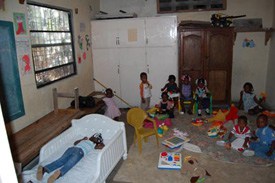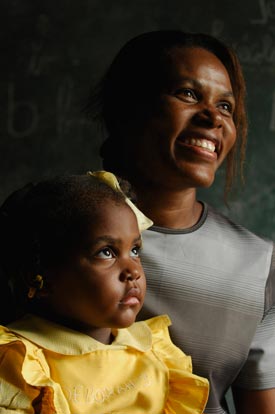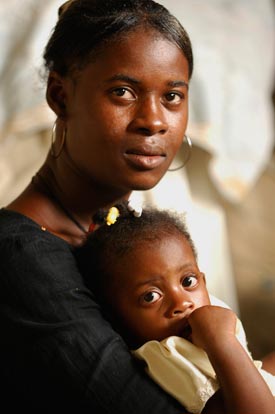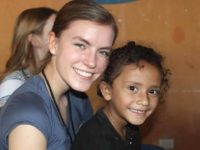After passing by a hazy eastern tip of Cuba, our American Airlines flight banked steeply to the right and within minutes we were passing over the northern peninsula of Haiti, so recognizable due to the heavily rutted landscape.
The French had not been kind when they ravaged the once-lush western half of Hispaniola of all the mahogany trees and shipped the lumber back to Paris to make fine furniture.
More than 200 years later, the nation is still 90 percent barren, and what little good topsoil remains is eroding into the Caribbean.
We circled over the Canal du Sud strait approaching Port-au-Prince, a teeming city I had not been to in 19 years. As we touched down on the single runway “international” airport, memories began to take focus.
Child Survival – What Does Ti Chape Means?
I’ll never forget that trip. A wiry American with a unique accent was my guide. He had been living in Haiti for six years, assisting with various ministries, and eventually signing on full time with Compassion. His name was Wess Stafford.
It was on that trip that I snapped one of my all-time favorite photos: a little child of about 3 with a distended belly, wearing a ragged striped T-shirt and nothing else, proudly hoisting his torn little handmade kite on a 10-foot string made of scraps of twine and wire he had found.
The breeze was only keeping the kite about 5 feet aloft, but the boy was as gleeful as any child I had ever seen.
Wess was seated next to me in our van, and noticed my fascination with the tiny urchin.
“Ah, yes … another little Ti Chape.”
“What is a Ti Chape?”
“It’s a Creole phrase that many parents in these poorest areas of Haiti use with their youngest kids. I’m sure you’ll hear it often over the next several days as we visit homes. It’s a term of endearment … but also a harsh reality that reminds everyone of how devastating each day can be for people living on the brink. Ti Chape means little survivor or one who has escaped death.”
As a very tenderhearted man, Wess could not conceal his passion, and tears began to well in his eyes. With a catch in his throat he continued:
“Sadly, for the majority of the poor here in Haiti, the infant mortality rate is as high as 50 percent for children under the age of 5.
“Often parents won’t refer to their littlest ones by their birth name until they celebrate their fifth birthday because they know all too well that many of them won’t make it that far.
“While they are still in this most vulnerable toddler stage, the children are affectionately called Ti Chape.
“I guess it is often too painful to consistently call them by their real names for fear of assigning too much hope to their prospects.
“This same phenomena happens, by different names of course, in other desperately poor cultures around the globe.”
I watched intently for a few more minutes as that toddler joyfully tried to keep his tattered toy buoyant on the air. Then we lurched forward in the traffic flow.
For the rest of our stay I pondered what that child’s chances of survival really were.
Even now, whenever I look at that tyke’s photo in my collection, it gives me great pause, and those feelings all came back to me as we drove through the packed streets of Port-au-Prince again.
On the trip’s final day, we drove out the N2 highway along the southern Massif de la Hotte peninsula, weaving past colorfully painted tap-taps (old pickups converted into buses often over-loaded down with upward of 20 people), soot-spewing diesel trucks, and U.N. troop patrol vehicles that help keep the peace in the politically unstable environment.
We were headed out to see one of our child development centers — one that had been in existence for 23 years, but had added a new program just a few years before, a program that is helping revolutionize our work: our Child Survival Program.
Child Survival – Rescuing, Nurturing and Discipling Little Ones
When we arrived in the rural town of Papette where our local church partner had become a real community center over the past two decades, it was obvious that the 1,000 residents had a deep respect for all that the church had helped them with.
My group and I were ushered into the sanctuary where 93 mothers and their infants had been patiently waiting. It was amazing how quiet and disciplined the 120 or so little ones were — we commented amongst ourselves that the same scene in America would’ve been utter pandemonium.
There was a look of gentle appreciation on the face of each young woman when we made eye contact.
A handful of the moms came forward to give testimony to what had revolutionized their lives.
Over Compassion’s 57 years of existence, we’ve always been laser-beam focused on child development for kindergarten-age kids through high school. But in the past five years we launched our Child Survival Program, which supports mothers and children all the way from their pregnancy on into infancy and through the toddler years.
One of the young mothers, Irmice, had her little 18-month-old boy draped on her shoulder, fast asleep, as she shared with the crowd.
“I serve a living, loving God. If not for Him or Compassion, I, and certainly not my baby, wouldn’t be alive today.”
She went on to explain the loving care and instruction she had received from the Child Survival Program staff, nurses and social workers who showed her how to improve prenatal health via exercise, nutrition and supplements. Then after her son was born, the encouraging practical lessons like proper breast-feeding, preventive vaccines, immunizations and other medicines continued.
 On a subsequent tour through the child survival wing of the church we saw cribs, tiny chairs, baby swings, scooters, tricycles, a huge supply of learning toys and instruments, exercise mats, building blocks, and everything else you would see in a well-run education-based nursery. They even had weekly classes for social interaction/training and early literacy.
On a subsequent tour through the child survival wing of the church we saw cribs, tiny chairs, baby swings, scooters, tricycles, a huge supply of learning toys and instruments, exercise mats, building blocks, and everything else you would see in a well-run education-based nursery. They even had weekly classes for social interaction/training and early literacy.
For these moms, who come from households where the average monthly income is perhaps $40 at best, this is a sanctuary for their babies in the truest sense of the word.
The Child Survival Program center Director, Rose, explained how the tots are regularly weighed, measured and examined to make sure they are within healthy parameters. There was a full pharmaceutical closet with everything a young mother could need for her child. Extensive files are kept on each mom and baby, and they’re regularly updated with information gathered from the weekly visits to the homes and the families visits to the center.
 I was thoroughly impressed. And the results were obvious in the shiny eyes, gleeful giggles, and yes, even the healthy full-throat wails of some little nippers.
I was thoroughly impressed. And the results were obvious in the shiny eyes, gleeful giggles, and yes, even the healthy full-throat wails of some little nippers.
I saw the wall charts that are proudly displayed showing the progress of each and every infant that had come through the program … and not a single one had died.
In fact, once the 3-year-olds “graduate” from the Child Survival Program, they then become eligible for our Child Sponsorship Program, and all of them from four to five years ago were enrolled there!
Outside the center, I saw some healthy-looking kindergartners sailing their tattered kites. They were in their school uniforms, with good shoes on their feet.
I always like asking these little Haitian dynamos their names. It swells my heart every time to hear them proudly blurt out their moniker: Pierre! Camille! Sebastien! Monique! Alain! Simone! Yves!
And when I asked these mothers on to introduce their littlest ones, there wasn’t a single Ti Chape in the bunch.
Support a Child Survival Program
Editor’s note: Mark wrote this post about a trip he took to Haiti in March 2008. He originally published it on his MySpace page and allowed us to share it with you here, in its entirety. The photos are not from his trip, although they are from child survival programs in Haiti.

 “Sadly, for the majority of the poor here in Haiti, the infant mortality rate is as high as 50 percent for children under the age of 5.
“Sadly, for the majority of the poor here in Haiti, the infant mortality rate is as high as 50 percent for children under the age of 5. 





13 Comments |Add a comment
Thank you for sharing this story with us. My brother suports a child survival program in Haiti.
Autumn: I took Randy Matthews on his trip to Haiti, and introduced him to the Ti Chape story. It is indeed a powerful song, and Randy has remained a great advocate for “the least of these” over all these years.
@Autumn –
I first heard of the term Ti Chape from a Randy Matthews song called Ti Chape. He explained the same thing you did here in this post. That song has always haunted me. I am glad that more visibility is being given to this plight.
What a great reminder of the hope given to these mothers and families through the CSP’s!
This would be a real encouragement to share with those considering CSP sponsorship.
God is so good, that he provided a way for these mothers and their babies. Beautiful are the hands that serve and give.
Beautiful story – thank you for sharing. It’s great to see how Compassion is impacting the lives of children and their families.
This post hits close to home. My family is waiting to bring home Daniela, our adopted daughter, from Cap Haitien, Haiti. Though we’d been to some of the poorest area’s of the Dominican Republic before, we were stunned when we saw the poverty in Haiti. Thanks for the great post.
Incredibly well written. Thanks for taking us there with you.
I don’t think Compassion will ever not be needed 😉
Great story, great testimony to what God is doing through Compassion!
Thanks for sharing!!!!!!!
Beautiful post! Thank you so much for sharing this.
Thank you, Mark! I love this article. We help to sponsor a CSP in Haiti, and this story made me feel as if I have just visited it!